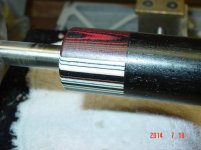Here is how you start to make a mess.
I have made the phenolic linen tube on one of my older lathes. Wanted to try it out to see how it would work, also wanted to see how haring bone linen and denim would work. It took a little ingenuity to get the proces to work. the first couple times I made the tubes were total disasters, and be ready to waste a lot of time and materials getting it right. Here is the basic process I came up with in a nut shell.
Start with what ever linen you want, go down to your local sewing shop and find the stuff you want. keep in mind the thinner the matierial the better. You want it to soak up the epoxy. Next go down and find your self the slowest curing epoxy you can get. If you get something that fires off too fast, you will not have time enough to work with it. I found some of the bar top product, or surf board epoxys work good. You will also need some way to press the product while it is being wrapped. I found steel rollers for material handling at Home Depot that work well. The rollers i picked up where about 12" in length, while you are at the homies depo, pickup some wooden dowels to wrap it on. You will need different diameter dowels, 1/4", 1/2" 5/8" ect. This will take up the inside of your tube and will give you something that is easy to drill out after everything is cured, you will also need soome plastic tubs that are wider then the rollers you are buying, you will need these to soak your linen in and to keep from dripping epoxy all over your lathe. I found cat litter pans work great for this, you can go down to Petco and pick up some cheap ones that are lower on the sides. Might as well get some plastic sheeting to cover all the stuff you dont want epoxy on too.
Now is where the fun begins "and the Mess" trust me. Start with a length of rod in the lathe, longer then the length of the presss roller you are using. Use some masking tape and tape the end of your linen you are using to the wooden dowel. Wrap the linen around the rod and get a good idea of the lenght you will need to get the disired diameter of finished rod you want, then add some more wraps for pressing and some more for turning down. Bigger is always better, within reason of course. Long strips of linen are best and you will find it will not take too much to get the diameter you want using the proper size dowel. Now tape off and cover everything you dont want epoxy on. I even went so far a putting a releasing agent on the chuck of my lathe so the mess would be negotiable once the process was complete. Unroll the linen back off the rod and get it to where it will stay straight during the rolling process. I found that wrapping it on another peice of dowel worked good. I made a jig to hold the rod on V blocks away from the lathe with the cat pan under it, you could just cut two V's in the pan to let the dowel sit and allow it be rolled on.
So now you got your linen attached to the rod on the lathe, and it is extended out to the rod across and in the cat pan. If you roll your lathe by "Hand" mind you it should roll smoothly from one rod to the next. Now all you got to do is take your time, soak the linen with epoxy as you roll it on the rod in the lathe. Do your best to keep it tight during this process. Wrap it on using plenty of epoxy, if you are not making a mess here you are probably not using enough epoxy. Once the linen is all wrapped on the wooden dowel in the lathe, use the steel roller you purchased and start to press it out by hand. I made a jig for this also that could be pressed against the piece. You will have a lot of epoxy rolling out of the linen. After I had the majority of the excess epoxy off the tube I would start the lathe spinning very, very, slowley at a snails pace and use the steel roller to press it out. The first rod I made I did not have the roller mounted to my lathe and had to sit there and hold the roller until the epoxy fired.. Live and learn I guess. Once you get it down it is rewarding.
After the epoxy cures you can put it on your regular lathe cut the OD down and drill out the wooden dowel and get the ID you want. Wal La, instant phenolic with a big mess to clean up. Just remember it will never be cost effective doing it this way, more customized? Yes. But way more expensive, but thats the cost you pay for experience. Good luck if you decide to try it.
I think the next time I decide to try this I am going to build a wooden box contraption with a roller and a press tool in it that would mitigate the mess made, now the mind is working on that Aloha print I was looking at. LOL have fun and good luck

